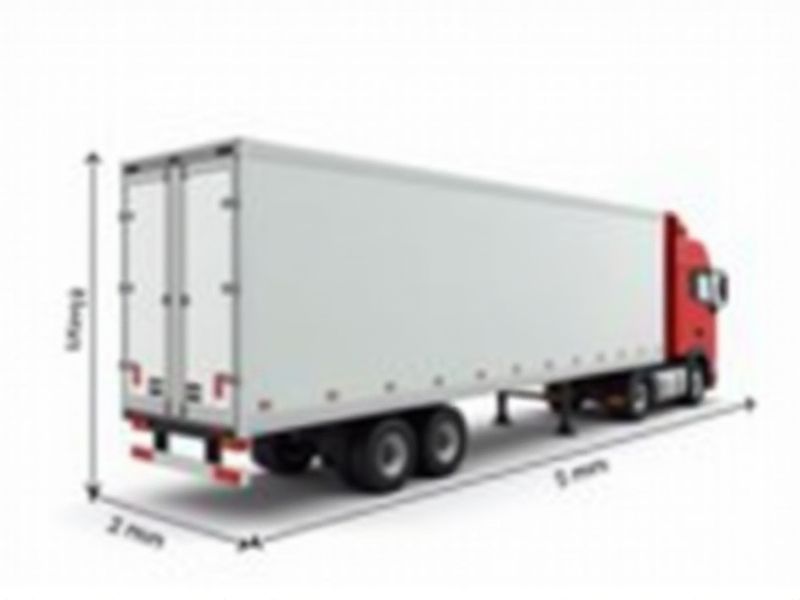
When considering semi-trailers, understanding standard dimensions helps ensure compatibility with loading docks and adherence to road regulations. In the United States, a typical dry van semi-trailer is about 53 feet long, 8.5 feet wide, and 13.5 feet high. European semi-trailers are usually a bit shorter, commonly measuring around 13.6 meters (about 45 feet) in length. Knowing these measurements can aid in planning for cargo capacity, route restrictions, and efficient logistics operations.
Length: 53 Feet
The standard length for a semi-trailer is 53 feet, which maximizes cargo capacity while adhering to federal regulations. This size enables transportation companies to optimize logistics and reduce shipping costs, as it typically allows for a maximum payload of around 45,000 pounds. In some states, 53-foot semi-trailers can provide a significant efficiency advantage in long-haul trucking as they can carry more goods per trip compared to shorter trailers. Understanding these specifications can help you make informed decisions when selecting the best equipment for your business needs.
Width: 8.5 Feet
The standard width of a semi-trailer is 8.5 feet, which enhances stability and maneuverability on highways. This width allows for optimal cargo capacity while adhering to federal and state regulations, ensuring compliance for transportation across various jurisdictions. With this standardized dimension, you can expect improved safety and reduced risk of accidents during transit. Most semi-trailers also accommodate a maximum vehicle width of 102 inches, allowing for a diverse range of freight types.
Height Clearance: 13.5 Feet
The standard height clearance for a semi-trailer is 13.5 feet, which is crucial for navigating under overpasses and bridges. This vertical limit ensures compliance with transportation regulations across various states while minimizing the risk of accidents. To maximize cargo capacity, many truckers opt for trailers designed within this optimal height range. Ensuring your vehicle adheres to this measurement can significantly enhance safety and efficiency when transporting goods.
Maximum Payload: 45,000 Pounds
The maximum payload capacity of a standard semi-trailer is typically 45,000 pounds, ensuring efficient transportation of goods. This weight limit is crucial for complying with federal and state regulations. With various trailer types designed for specific cargo, you can optimize your load for safety and balance. Many semi-trailers also feature advanced materials and designs to enhance durability while maintaining this weight capacity.
Gross Vehicle Weight: 80,000 Pounds
The standard for semi-trailers focuses on a gross vehicle weight of 80,000 pounds, ensuring optimal performance and safety on roads. This weight limit allows for a distribution that maximizes cargo capacity while minimizing the risk of damage to infrastructure. Typically, a semi-trailer can carry a payload of approximately 45,000 to 50,000 pounds, depending on the trailer configuration and type. Understanding these weight parameters is crucial for compliance with federal regulations and for efficient transportation logistics.
Kingpin To Rear Axle: 41 Feet
The standard distance from the kingpin to the rear axle of a semi-trailer is 41 feet, which ensures optimal weight distribution and stability during transport. This measurement is crucial for complying with federal regulations and maintaining safety standards on the road. By adhering to this standard, you can minimize the risk of accidents and enhance the overall performance of your vehicle. Understanding and implementing this distance is essential for effective logistics and cargo management.
Tandem Axle Spread: 8 Feet
A standard semi-trailer typically employs a tandem axle spread measuring 8 feet, crucial for weight distribution and stability. This configuration allows for optimal handling and reduces tire wear, especially during turns. With an 8-foot spread, you can expect enhanced traction and improved braking performance, particularly under heavy loads. For operators, understanding this dimension is essential for compliance with regulatory requirements and maximizing payload efficiency.
Floor Height: 48 Inches
The standard floor height for a semi-trailer is typically set at 48 inches, which optimizes loading efficiency and accessibility. This height allows for a seamless transition when loading and unloading cargo, reducing the risk of injuries or accidents. Many logistics companies prefer this specification to enhance the overall performance of their fleets. By adhering to this standard, you can ensure compatibility with various loading docks and equipment.
Wheelbase: 40 Feet
A standard semi-trailer typically features a wheelbase of 40 feet, providing optimal stability and support for heavy loads. This extended wheelbase enhances the turning radius, making it easier to navigate through tight spaces, while also distributing weight more evenly across axles. With a payload capacity often exceeding 30,000 pounds, these semi-trailers are designed for various freight types, ensuring efficient transport. Your choice of a semi-trailer with a 40-foot wheelbase may lead to improved fuel efficiency and reduced wear on tires, maximizing operational performance.
Interior Height: 110 Inches
The standard interior height of a semi-trailer measures 110 inches, providing ample vertical space for cargo. This height is designed to accommodate various types of freight, including tall equipment and pallets. You can maximize loading efficiency by utilizing this vertical clearance to stack goods effectively. Understanding these dimensions helps ensure compliance with transportation regulations and optimizes your logistics operations.
